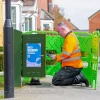BT Ponder More Cost and Dividend Cuts to Fuel FTTP Broadband Rollout
BT’s top brass has this week warned investors that they may have to reduce capital expenditure, cut costs, borrow more and reduce their dividend in order to fund the planned rollout of Gigabit capable Fibre-to-the-Premises (FTTP) broadband ISP technology, which aims to reach 15 million UK premises by around 2025.
At present the telecoms giant is still working its way through last year’s strategy from their former CEO (Gavin Patterson), which among other things involved cutting 13,000 jobs over a three year period (here). This was somewhat mitigated by the hiring of several thousand additional engineers at their Openreach division. The problem is this won’t be enough.
BT currently forecasts that it should generate an average normalised free cash flow of £2bn in the year to March 2020 but that falls to around £900m when you factor in pensions and other costs. At the very least this implies that the operator’s current cash dividend payout of £1.5bn is unsustainable in the current climate, although it was maintained at the last report.
Advertisement
However BT’s new CEO, Philip Jansen, said this week (FT paywall) that it would cost “roughly” £400m to £600m (capital expenditure) a year to meet their FTTP ambition of 15 million UK premises by around 2025. Back in May 2019 Openreach said they were delivering FTTP at the “lower end” of their £300 – £400 per premises passed cost range (here) and could “pass around 50% of UK premises within this range of costs” (i.e. £4.5bn to £6bn for the first 15 million premises).
Openreach previously estimated in 2017 that reaching just 10 million premises could cost between £3bn to £6bn and costs rise disproportionately the further you go outside of the most lucrative urban areas.
Perhaps unsurprisingly BT’s Chairman, Jan du Plessis, this week warned investors at the company’s annual meeting that the dividend payout may have to be reduced in a “year or two,” which would be used to help fund their “full fibre” deployments. Jan also hinted at additional support by reducing capital expenditure in other areas, cutting more costs and extra borrowing.
The company’s new CEO, Philip Jansen, is already rumoured to be considering another round of significant job losses when the current programme of cuts comes to an end (here). One report even predicted that as many as 25,000 staff from its 100K strong workforce could be on the chopping block (not engineers though, obviously).
Advertisement
Lest we forget that BT doesn’t only have FTTP costs to consider going forward. Elsewhere there are also big challenges in 5G deployment and future spectrum auctions, growing debt, TV content and so forth. Clearly there are no short-term fixes here and it will be a long road back to recovery, which also assumes that the operator can fend off a growing market of alternative networks.
Mark is a professional technology writer, IT consultant and computer engineer from Dorset (England), he also founded ISPreview in 1999 and enjoys analysing the latest telecoms and broadband developments. Find me on X (Twitter), Mastodon, Facebook, BlueSky, Threads.net and Linkedin.
« Mobile Firm giffgaff Accused of Providing Inaccurate Info. to Ofcom

















































Comments are closed